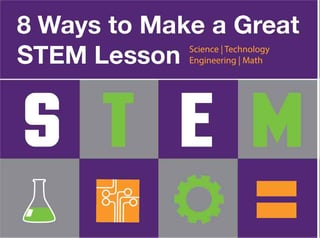 What is STEM?
What is STEM?
The acronym stands for Science/Technology/Engineering/Math, and it typically is used when addressing education policy and curriculum choices in schools to improve competitiveness in science and technology development. STEM Curriculum Specialist Nancy Tsupros defines it more specifically as follows:
STEM education is an interdisciplinary approach to learning where rigorous academic concepts are coupled with real-world lessons as students apply science, technology, engineering, and mathematics in contexts that make connections between school, community, work, and the global enterprise enabling the development of STEM literacy and with it the ability to compete in the new economy. (Tsupros, 2009)
STEM was created to encourage a greater focus on science and math disciplines, in order to build a workforce equipped for the high-tech jobs in the future. Simply teaching math and science using technology cannot accomplish this. STEM is about changing the way we approach these disciplines. It’s about going beyond the classroom and prepping students for the real world.
How do you create lessons that are STEM-focused?
There are many ways to incorporate STEM fundamentals and create interactive, collaborative, and dynamic lessons that teach skills for the real world. Following are eight great ways to ROCK STEM.
- Make activities hands-on. Activities should provide roll-up-your-sleeves learning. They should be about doing. Ideally, students will collaborate and solve the problems together, and gain a more involved and deeper understanding. Karen Worth, a senior researcher and longtime science educator at Education Development Center (EDC), points out that hands-on learning in not “simply manipulating things.” Rather, it is “engaging in in-depth investigations with objects, materials, phenomena, and ideas, and drawing meaning and understanding from those experiences.” Other terms for this are inquiry learning and minds-on learning.
- Enhance activities with technology. Use it or create it! Using technology means more than just presenting a lesson on an IWB or using a document camera. It means bringing the technology into the lesson in a way that adds value and takes the activity to a new level. A good example is the technology LabDisc, a device that is used with a tablet to put a lab in the palm of your hand. LabDisc allows students to measure their world, analyze real-time data samples, and develop a skilled scientific response. This particular technology enables students to gather data and information at a pace that would otherwise be impossible.
- Follow the engineering design process. The engineering design processis a stepped process that helps teams solve problems. The process is cyclical, meaning that the process is repeated as needed to reach the desired solution. The key aspects for students to grasp from this process are the importance of teamwork, the need to be creative, and the open-ended nature of the work. This video shows the engineering design process being used in a real-world example of building skyscrapers: http://www.pbslearningmedia.org/resource/phy03.sci.engin.design.desprocess/what-is-the-engineering-design-process/.
- Encourage and enable collaboration. The ability to work together is a trait necessary for success in STEM activities and in life. Learning how to collaborate successfully allows for deeper learning and helps students gain valuable life skills. This tip sheet for educators is useful for fostering teamwork in STEM learning: http://www.middleweb.com/wp-content/uploads/2012/08/7-Student-Teaming-Tips-MW.pdf. For more collaboration tips and lessons, check out this guide: http://news.mimio.com/collaborate-to-the-core-2015-web.
- Choose real-world problems. STEM lessons should hinge around real-world problems so that students can come up with real-world solutions. Here are some great lesson sites that combine science with real-world issues:
https://www.neefusa.org/ This site focuses on the environment and real-world science with infographics, videos, and other online content.
Discovery Education and 3M came together to create lessons that use things you have in the classroom to explore everything from the science of sports to innovations in health. http://scienceofeverydaylife.discoveryeducation.com/teachers/six-to-eight.cfm
The MimioConnect® website lets you explore a range of science lessons by grade and subject, with files on everything from extreme weather to atoms. http://mimioconnect.com/lessons/17/all/all/new
- Keep the whole class interested. Make sure the STEM lessons and activities are not skewed toward the boys. STEM is about being inclusive and encouraging teamwork. All team members should participate and find common interests they want to explore. Poll both boys and girls in the classroom for project ideas and real-world problems. And make sure teams are created in a way that encourages an open and inclusive dynamic.
- Reinforce math and science standards. Try to find real-world projects and activities that link back to science and math standards. This will ensure that what students are learning aligns with the Common Core State Standards.
Here’s a great resource for math projects and standards: http://www.stemcollaborative.org/.
Science standards and lesson ideas can be found here, listed by grade level: http://sciencenetlinks.com/collections/stem-and-common-core/.
- Challenge students to find multiple answers. A big aspect of STEM is solving a problem, but make sure your students don’t have a one-answer mentality. Explore multiple solutions, even though digging down to the next level can be hard. Being challenged is what pushes students to learn and to be creative.
Do you have ideas of your own on ways to make lessons more STEM-focused? We’d love to hear them. Post your suggestions here.


